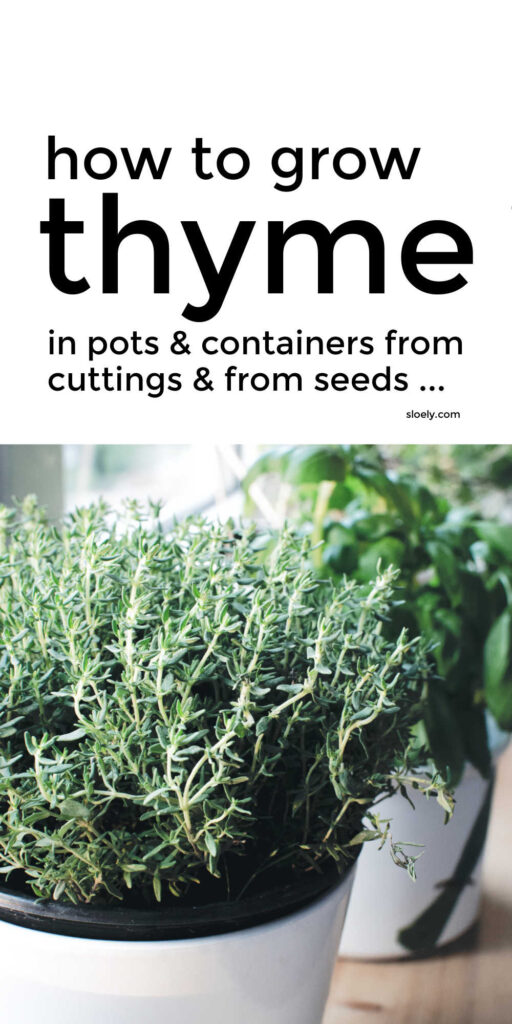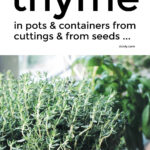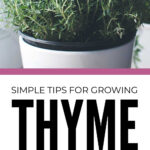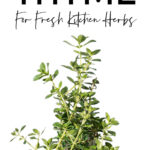
Thyme is a tiny but tough herb that is super easy to grow from cuttings and seed but packs a seriously powerful punch in the kitchen and natural remedies.
Thyme is a must grow if you're beginning a herb garden or just fancy growing herbs in containers indoors in your kitchen.
Thyme is also a brilliant addition to a vegetable garden especially if you'd love to garden more organically as it repels pests naturally and attracts pollinators. Thyme is even a natural mosquito repellent.
So I've got for you here everything you need to know about how to grow thyme from cuttings and seeds easily and how you can put it to work in simple home remedies and an organic garden ..
Table of Contents
Health Benefits Of Thyme
Thyme is a wonderful herb to grow in a simple herb garden as it is a natural antibiotic that can be used as a:
- Home remedy for sore throats
- Natural antihistamine for allergy relief
- Simple remedy for tummy bugs
- Natural treatment for intestinal worms
- A natural way to prevent hair lice
- Gentle way to ease acne
- Natural remedy for yeast infections such as thrush
And you don't have to be a fancy herbalist to enjoy the health benefits of thyme from your garden. A simple thyme tea will do the trick.
How To Grow Thyme From Cuttings In Water
The quickest and easiest way to grow thyme for your herb garden is from cuttings in water. Thyme will not grow as quickly from cuttings as mint, oregano or parsley but it it is still very easy :
- Take a few 3 inch cuttings from a thyme growing neighbour.
- Cut at a point where leaves are sprouting (a leaf node).
- Remove the lower leaves.
- Put cuttings in a jar of water.
- Keep in a sunny warm spot.
- Roots will appear after roughly 6 weeks.
- Wait a few weeks for a healthy bunch of roots before planting in a container.
You can grow thyme from cuttings in slightly damp soil as well as water. Some gardeners recommend this as thyme doesn't like much water. But the big advantage of growing thyme from cuttings in water is you can see what's going on and you don't have to disturb your cutting to check roots.
How To Grow Thyme Indoors
Thyme is very easy to grow indoors as it is one of the smaller herbs. It also likes warmth so will flourish indoors when too cold for it outdoors.
To grow thyme indoors successfully:
- Start thyme from cuttings.
- Transfer to small pot of soil with stones at the bottom so it drains well.
- Place in a sunny spot.
- Will flourish as long as temperature between 16c / 60 f and 32 c / 90 f.
- Only water when soil is dry.
- Prune all over in early spring and a third of the plant after flowering.
- Divide plants every few years so don't over grow pot.
How To Grow Thyme From Seed
Thyme is easy to grow from seed but it isn't quick.
Thyme seeds can take a month to germinate and only germinate reliably above 21 c / 70 f. Typically you should only harvest thyme in the second year so you will have to wait a bit.
The great advantage of growing thyme from seed is that you can pick your own good quality variety. See Buying Thyme Seeds & Plants below.
If you do want to grow thyme from seed:
- Start sowing indoors from March.
- Scatter a few seeds per small pot, cover very lightly with soil.
- Water scarcely.
- Plant out when temperature is consistently above 16 c / 60 f. This is typically May in the UK.
What Soil Does Thyme Like
Thyme, like oregano, lavender and rosemary, is very happy in poor soil. You can grow thyme in any potting compost you've got but it can be worth mixing in a good helping of thin garden soil and some grit and pebbles to improve drainage.
Thyme plants will not need feeding unless you are growing in containers in which case some gardeners recommend a regular seaweed feed. But other gardeners argue even thyme in containers doesn't need feeding and if you want to begin gardening organically you should avoid nitrogen feeds as much as possible.
How Much Water Does Thyme Need
Thyme needs very little water and is drought resistant. Thyme will only need watering outdoors if grown in containers.
If you are growing thyme indoors or in containers outdoors only water scarcely when the soil is dry. Don't plant thyme with other herbs that need plenty of water. e.g. mint, parsley & chives.
If you are growing thyme in a wetter climate, you may unusually want to give it some rain cover, so it doesn't get too wet.
When To Plant Thyme Outdoors
Thyme loves sunshine and warmth so only :
- Plant thyme seeds outdoors when the temperature is above 21 c / 70 f.
- Transplant thyme seedlings outdoors when the temperature is consistently above 16 c / 60 f which is typically May in the UK.
How To Grow Thyme In Containers
Thyme grows well in containers both indoors and outdoors. Key tips when growing thyme in containers are :
- Thyme will grow well in a 1 to 2 litre pot, with a 13 to 17 cm diamater.
- Make sure the thyme container drains well.
- Adding stones or grit at the bottom of the container will help drainage.
- Raising the container on a stand or a few bricks will also help drainage.
- Traditional clay pots make good containers for thyme as they retain heat.
- Divide thyme plants in containers if they out grow the pot.
Some gardeners claim thyme grown in containers needs regular feeds of seaweed. Other gardeners disagree and organic gardeners encourage us to avoid nitrogen feeds as much as possible. I don't feed mine.
What Does Thyme Grow Well With
Growing Thyme As A Companion Plant
Thyme can be very useful companion plants that can repel aphids and caterpillars and attract pollinators. Plant thyme as a companion plant to:
- Repel aphids including green fly, white fly and black fly on roses and brassicas including collards and spring greens.
- Repel caterpillars on strawberries, tomatoes and aubergines.
- Attract pollinators to fruit plants such as blueberries.
Growing Thyme In A Herb Garden
Thyme is a must in any herb garden with its delicious flavouring and multiple health benefits. But that doesn't mean you can shove thyme in a herb garden with lots of other herbs and expect it to thrive, it won't!!
There are two key things to remember growing thyme in a herb garden :
- Thyme loves hot, sunny, near drought conditions with very little water.
- Thyme is sturdy and resilient but small & easily suffocated by bigger or faster growing herbs.
The easiest way to grow thyme in a herb garden is in a container where it can do its own thing but if you do want to grow thyme in a herb bed:
- DON'T plant thyme with water loving herbs such as mint, chives, parsley or basil.
- DON'T plant thyme with large or rapidly growing herbs. I frequently see tips for growing rosemary with thyme but in my experience rosemary will totally over power thyme. And even quick growing sage in my experience can suffocate the slower growing thyme.
- DO plant thyme with other drought resistant herbs that don't grow too big or too quickly such as oregano, lavender and marjoram.
There are some lovely different types of thyme including lemon thyme - see Buying Thyme Seeds & Plants below - so you can add variety to your herb garden simply by planting different types of thyme.
How To Prune Thyme
It's easy to forget to prune thyme or just not bother as it's not a big plant. But don't forget. Thyme does need pruning from its second year onwards.
Once the danger of frost is past prune thyme as follows:
- Cut right back any very woody stems with no new growth on them.
- Cut right back any very long thin, spindly, woody stems.
- Cut back non branching stems to just above the first pair of leaves.
- Trim new growth all over to the first pair of leaves.
The pruning will seem a bit drastic but will stimulate much healthier, thicker growth rather than lots of weedy, twisted stems.
Prune one third of the plant again - cutting to the first pair of leaves - after flowering if you haven't harvested the thyme for drying or preserving.
How To Harvest Thyme
From the second year after planting, you can happily harvest thyme as and when you need it. If you use the key pruning tip of cutting to just above the first pair of leaves on a stem you will stimulate stronger rather than thin spindly growth.
Harvesting Thyme For Drying Or Preserving
If you're harvesting thyme for drying or preserving, you want to harvest when the thyme's flavour is at its strongest, which means :
- Just before flowering at the beginning of summer.
- In the morning.
Thyme Pests & Diseases
Thyme is a resilient little herb that struggles with few pests and diseases. Thyme may occasionally suffer with rosemary beetles and alternaria blight.
Rosemary Beetles On Thyme
You may sometimes spot rosemary beetles on thyme. They can do a lot of damage in a short time but both larvae and beetle are very easy to see on the thyme and can be easily removed manually and squidged.
Alternaria Blight On Thyme
Alternaria blight is a fungal disease that can impact not only thyme but anything from tomatoes to collard greens. It appears as rusty brown and eventually black marks on leaves that are initially circular.
As with most blight the key to prevention is basic garden health including:
- Good air circulation between plants by spacing well and pruning.
- Thoroughly cleaning secateurs between use.
- Quickly removing any leaves or fruit showing signs of blight. Get them out of the garden and don't compost them.
- Crop rotation so you don't keep growing the same thing in the same spot year after year.
- Growing garlic as a companion plant to feed soil with sulphur as a natural fungicide.
How To Grow Thyme Organically
Thyme can be very useful in an organic garden with its natural ability to repel aphids, caterpillars and beetles and to attract pollinators.
It is very easy to keep on top of the few pests and diseases thyme can suffer with manually so if you want to grow thyme organically there should be no need for artificial pest control. They can be managed manually.
Tips for growing thyme in containers will typically recommend regular if not weekly nitrogen rich feeds but constant addition of artificial nitrogen to our gardens can cause nitrogen pollution so if you want to garden more organically try to cut out artificial nitrogen feeds and top up nitrogen naturally with your own compost.
Buying Thyme Seeds & Plants
You can buy a range of different thyme seeds and plants if you haven't the patience to grow thyme from cuttings or seeds. Combining a range of different thyme varieties can add pretty colour and fragrance to even a tiny herb garden and will be especially attractive to pollinators.
Thyme seeds and plants to look out for include :
- Common thyme : thymus vulgaris - pretty pink flowers
- Archers gold thyme : thymus pulegioides - lilac flowers, lemon scent
- Wooly or wild thyme : thymus polytrichus - pink, purple & white flowers - very attractive to bees
- Lemon thyme : thymus citriodorus - lovely powerful lemon fragrance, yellow edged leaves
- Jekka thyme : thymus jekka - great flavour - pink & white flowers
- Snowdrift thyme : thymus serpyllum - very pretty white flowers
If you are looking for thyme seeds and plants in the UK it is always worth checking out the RHS (affiliate link) for very good quality, organic products. I have bought a good share of my herbs plants from the RHS over the years and they have really thrived. They usually have a good range of really lovely thyme varieties on for sale.
And there you go, absolutely everything you need to know about growing thyme from cutting and seeds easily in a little herb garden or just in containers indoors in your kitchen. Do give it a go, it is a delight to grow.
For more simple tips on growing herbs do check out these other posts:
- How To Grow Parsley Quickly From Cuttings & Seed
- How To Grow Oregano Easily From Cuttings & Seed
- How To Grow Rosemary From Cuttings Indoors & Outdoors
- Growing Mint In Pots From Cuttings
- Growing Garlic As A Companion Plant
- How To Grow Chives As Companion Plants

Original image source : rawpixel.com













Leave a Reply